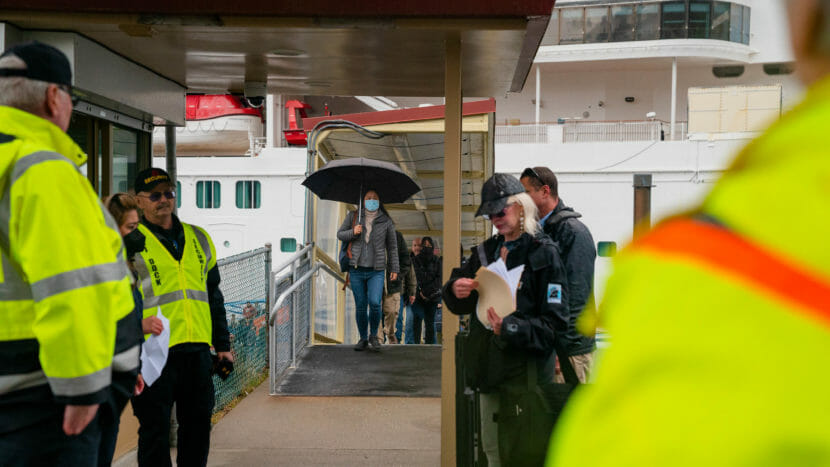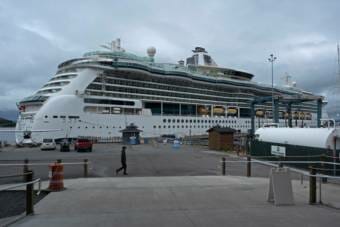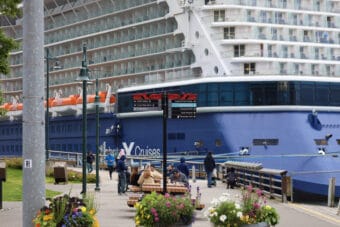
One passenger on a recent Carnival cruise bound for Seattle claimed there were about 200 people sick with COVID-19 on board, and that the crew were overwhelmed. Carnival downplayed the situation with Seattle press, but wouldn’t disclose the case count.
That ship, the Carnival Spirit, is now cruising between Seattle and Southeast Alaska for the summer. If its crew are following protocol, the Centers for Disease Control and Prevention, the U.S. Coast Guard and the Alaska Department of Health and Social Services should all have good data about the COVID situation on board on any given day. But very little of that information is available to the public for the Spirit, or any of the ships operating in Alaska this summer.
This year, the cruise lines operating all of the big ships in Alaska committed to regularly report illness data by opting into the CDC’s COVID-19 Program for Cruise Ships. They’ve agreed to fill out and send a form every day for every ship so the CDC can track COVID-19 cases on board.
Individuals’ health information is protected. That hasn’t stopped state health authorities from publishing individual communities’ overall case counts, hospitalization figures, hospital capacity, deaths or other stats helpful for gauging COVID-19 risk. But the CDC isn’t doing that for cruise ships.
The CDC does publish and update daily a color-coded cruise ship status on its website for each ship. Green means they have no cases of COVID-19 or COVID-like illnesses.
The Carnival Spirit has been in the orange category. That could mean as few as seven passengers are sick — or it could be hundreds. The majority of the ships sailing right now are in that category.
“To be expected, I would say. COVID is kind of prevalent everywhere right now,” said Juneau Deputy City Manager Robert Barr. Nowadays, hospitalization rates are a key metric he’s keeping an eye on. “And thankfully, we’re not seeing hospital impact significantly, locally or more broadly.”
Over 90% of the passengers and crew on cruise ships are vaccinated. That’s higher than the populations of the communities they’re visiting. The CDC says that scientists monitoring the effectiveness of the vaccines have seen protection against infection wane over time, but protection from severe cases that lead to hospitalizations persists.
The CDC’s most severe category for cruise ships is red, which indicates the medical capacity onboard is overwhelmed. Some of the Spirit’s recent passengers described a poorly managed COVID-19 outbreak that did overwhelm the crew. However, Carnival told Seattle press that there were no serious health issues and that it maintained its health and safety protocols.
The CDC has not made anyone available for an interview about its cruise ship program.
Like last year, the cruise lines have made a lot of commitments to Alaska port communities to reduce the spread of COVID-19 and to manage cases themselves. Cruise passengers and crew aren’t supposed to burden local health care systems. Barr said the agreements this year say that medical facilities in the bigger ports like Juneau, Ketchikan and Whittier could help out if the need arises.
“But occasionally, occasionally we can assist,” Barr said. “In the event that we can’t, then each line is required in the agreement to transport impacted passengers and/or crew to Seattle.”
The CDC’s description of its cruise ship program also says the Coast Guard is supposed to get the most timely information about illness before ships arrive in a port. The Coast Guard has not made anyone available for an interview about this.
That leaves the Alaska Department of Health and Social Services. It’s been regularly publishing COVID-19 data statewide on online dashboards of its own since the pandemic began. The data can be narrowed to specific Alaska regions and communities. But it’s not helpful for teasing out cruise ships.
Department spokesperson Clinton Bennett said lots of factors affect how cases identified aboard a cruise ship operating in Alaska get published. And there is potential for cruise ship cases to cause spikes in different communities’ COVID-19 data that don’t reflect higher risk.
For example, a cruise ship passenger could spend a day in one community, get back on board, test positive at sea, then end up in the case counts for the next port of call — even though they would stay quarantined aboard the ship.
Bennett said cases caught in Alaska waters could also be geographically tagged as “at sea,” which isn’t searchable.
“Our overall takeaway,” Bennett wrote in an email, “is that the dashboard case counts announced in relation to the cruise industry shouldn’t be relied upon alone in understanding impact to local communities or the total size of an outbreak on a vessel.”
When Sue Schrader heard that, she was dismayed. She’s a longtime Juneau resident who’s been concerned about cruise ship labor practices, the industry’s impact on Juneau and the environment.
“For those of us living in the community who maybe want to avoid going into busy shops downtown when we’ve got a four or five cruise ship day because of potential exposure, you know, we don’t have the information necessary to make those decisions,” she said.
Schrader said the anecdotes she’s read suggest passengers and crew are in the dark about COVID-19 outbreaks too.
The industry group Cruise Lines International Association Alaska said its member lines are voluntarily complying with the CDC’s program and protocols.
“Much like last year, we anticipate a successful season where we do not burden shoreside facilities and ports we visit,” said Renée Limoge Reeve, vice president of government and community relations for the CLIA, in an email.
Schrader is skeptical.
“This lack of transparency — you know, I’m sorry, but for CDC to expect the cruise ships to honestly report? … These are the same ships in many cases that have polluted our waters and falsified their pollution records,” she said.
Carnival and its subsidiaries, which include Holland America and Princess, recently completed a five-year probation period for the environmental crimes Schrader mentioned.
“And we’re supposed to now believe them that they’re going to report how many potential crew and passengers have COVID?” she said.
For the state’s top health officials, the answer appears to be yes. Health Commissioner Adam Crum and Chief Medical Officer Dr. Anne Zink recently described the cruise lines as good stewards in protecting public health on board and in the communities they visit. They say the industry has demonstrated its desire to be transparent, good partners.


